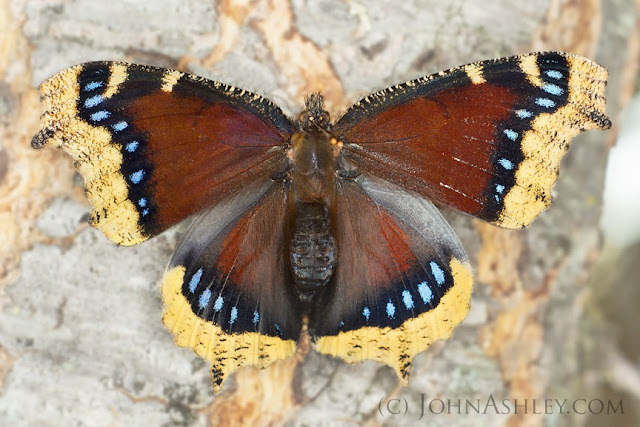 |
| A year-old Satyr Comma butterfly sunning its upper wings on a Montana spring afternoon |
Spring is finally afoot in northwestern Montana. Or should I say, "afloat?"
Chasing after spring butterflies is challenging here, because the early ones don't follow standard butterfly protocol. These guys went into hiding last fall and overwintered as adults. And now they seldom stop for flowers, so they are harder to find and follow (and photograph).
Most of what we see flitting about right now are angelwing and tortoiseshell butterflies, which belong to a group called the "true brushfoot" butterflies. This refers to the fact that two of their six legs are smallish and hard to see, making it look that they only have four legs. But, of course, all insects have six legs.
 |
| Satyr Comma underwing (click to count the legs) |
The former wears deeply scalloped wings (an "angelwing") with upperwings decorated by brown spots on a vibrant orange background. By contrast, our state butterfly has mostly brown wings that feature a dark band with blue spots, and a yellowish trailing edge.
Both of these are forest butterflies, more likely to be found flitting through the trees than across a meadow full of flowers. They prefer to feed on tree sap, rotting fruit and the occasional animal poop -- which contains valuable nutrients in spite of its presentation.
Last fall, these same adults sought out narrow crevices in trees where they spent the winter. On warm winter days, they might have emerged for a few short flights before returning to bed.
Early this spring, they were our first butterflies to emerge. They'll soon mate and lay eggs for a new crop of caterpillars. The year-old adults die off after egg-laying, but they will soon be replaced by a fresh "flight" of new adults in June and July. The new generation will then overwinter as adults and reappear early next spring -- when spring is finally afoot.
 |
| Freshly-emerged Mourning Cloak butterfly adult |

